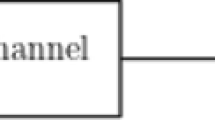Abstract
Sets of signals that meet Welch bounds with equality or near equality are of value in communications and sensing applications, and the construction of such signal sets has been an active research area. Although Welch derived a family of bounds indexed by positive integers k, only the first Welch bound (i.e., for k = 1) has been considered in these constructions. Earlier, a frame-theoretic perspective was introduced on the higher Welch bounds that is valuable in constructing signals that simultaneously meet multiple Welch bounds with equality or near equality. This perspective is used in this paper to examine the existence of signal sets that meet the kth Welch bound with equality by using second order Reed-Muller codes. Some examples of such signal sets are presented and connections to equiangular lines and t-designs are discussed.
Similar content being viewed by others
Notes
Given a finite frame X = {x1,...,xm} for an n-dimensional complex vector space V, the function \(F:V\rightarrow \mathbb {C}^{m}\) given by \(F(w)=[\left < x_{1},w\right > \ldots \left < x_{m},w\right >]^{\mathrm {T}}\) will be called the analysis operator associated with X, while \(\mathcal {F}=F^{*} F:V\rightarrow V\) (i.e., the composition of the adjoint of F with F) will be called the frame operator associated with X.
References
Welch, L.R.: Lower bounds on the maximum cross correlation of signals. IEEE Trans. Inf. Theory 20(3), 397–399 (1974)
Klappenecker, A., Rötteler, M.: Mutually unbiased bases are complex projective 2-designs. In: Proceedings of the International Symposium on Information Theory, pp. 1740–1744 (2005)
Strohmer, T., Heath, R.W. Jr: Grassmannian frames with applications to coding and communication. Appl. Comput. Harmon. Anal. 14(3), 257–275 (2003)
Waldron, S.: Generalized Welch bound equality sequences are tight frames. IEEE Trans. Inf. Theory 49(9), 2307–2309 (2003)
Sarwate, D.V.: Meeting the Welch Bound with Equality. DMTCS Series. Springer, Berlin (1999). Chap. 11
Xia, P., Zhou, S., Giannakis, G.B.: Achieving the Welch bound with difference sets. IEEE Trans. Inf. Theory 51(5) (2005)
Ding, C., Feng, T.: A generic construction of complex codebooks meeting the Welch bound. IEEE Trans, Inf. Theory 53(11) (2007)
Holmes, R.B., Paulsen, V.I.: Optimal frames for erasures. Linear Algebra Appl. 377, 31–51 (2004)
Massey, J.L., Mittelholzer, T.: Welch’s bound and sequence sets for code-division multiple-access systems. In: Capocelli, R., De Santis, A., Vaccaro, U. (eds.) Sequences, II: Methods in Communication, Security and Computer Science (Positano, 1991), pp 63–78. Springer (1993)
Datta, S., Howard, S., Cochran, D.: Geometry of the Welch bounds. Linear Algebra Appl. 437(10), 2455–2470 (2012)
van Lint, J.H., Seidel, J.J.: Equilateral point sets in elliptic geometry. Nederl. Akad. Wetensch. Proc. Ser. A 69=Indag. Math. 28, 335–348 (1966)
Delsarte, P., Goethals, J.M., Seidel, J.J.: Bounds for systems of lines and Jacobi polynomials. Philips Res. Repts. 30(3), 91–105 (1975). Issue in honour of C.J. Bouwkamp
Sustik, M.A., Tropp, J.A., Dhillon, I.S., Heath, R.W. Jr: On the existence of equiangular tight frames. Linear Algebra Appl. 426(2-3), 619–635 (2007)
Bodmann, B.G., Paulsen, V.I., Tomforde, M.: Equiangular tight frames from complex Seidel matrices containing cube roots of unity. Linear Algebra Appl. 430(1), 396–417 (2009)
Renes, J.M., Blume-Kohout, R., Scott, A.J., Caves, C.M.: Symmetric informationally complete quantum measurements. J. Math. Phys. 45(6), 2171–2180 (2004)
Grassl, M.: On SIC-POVMs and MUBs in dimension 6. In: Proc. ERATO Conf. on Quant. Inf. Science (EQUIS 2004), pp 60–61 (2004)
Scott, A.J., Grassl, M.: Symmetric informationally complete positive-operator-valued measures: A new computer study. J. Math. Phy. 51(4), 042203 (2010). https://doi.org/10.1063/1.3374022
Appleby, M., Chien, T.-Y., Flammia, S., Waldron, S.: Constructing exact symmetric informationally complete measurements from numerical solutions. J. Phys. A Math. Theor. 51(16), 165302 (2018). https://doi.org/10.1088/1751-8121/aab4cd
Scott, A.J.: SICs: Extending the list of solutions.arXiv:1703.03993 (2017)
Hammons, A.R., Kumar, P.V., Calderbank, A.R., Sloane, N.J.A., Sole, P.: The \(\mathbb {Z}_{4}\)-linearity of Kerdock, Preparata, Goethals, and related codes. IEEE Trans. Inf. Theory 40(2), 301–319 (1994). https://doi.org/10.1109/18.312154
Calderbank, R., Howard, S., Jafarpour, S.: Construction of a large class of deterministic sensing matrices that satisfy a statistical isometry property. IEEE J. Sel. Top. Sig. Process. 4(2), 358–374 (2010). https://doi.org/10.1109/JSTSP.2010.2043161
Kerdock, A.M.: A class of low rate nonlinear binary codes. Information and Control (1972)
MacWilliams, F.J., Sloane, N.J.A.: The Theory of Error-Correcting Codes. North-Holland Pub. Co (16) (1977)
Kantor, W.M.: MUBs inequivalence and affine planes. J. Math. Phys. 53. https://doi.org/10.1063/1.3690050 (2012)
Keung, R., Gross, D.: Qubit stabilizer states are complex projective 3-designs. arXiv:1510.02767 (2015)
Christensen, O.: An Introduction to Frames and Riesz Bases. Applied and Numerical Harmonic Analysis, 2nd edn. Birkhäuser, Birkhäuser (2016)
Thill, M., Hassibi, B.: Group frames with few distinct inner products and low coherence. IEEE Trans. Sig. Process. 63(19), 5222–5237 (2015). https://doi.org/10.1109/TSP.2015.2450195
Acknowledgements
The author is grateful to Doug Cochran for many useful discussions on the topic of this article. The author would like to acknowledge support from the Simons Foundation under Award Number 709212. The author also wishes to thank the anonymous referees for their suggestions.
Author information
Authors and Affiliations
Corresponding author
Additional information
Publisher’s note
Springer Nature remains neutral with regard to jurisdictional claims in published maps and institutional affiliations.
Rights and permissions
Springer Nature or its licensor (e.g. a society or other partner) holds exclusive rights to this article under a publishing agreement with the author(s) or other rightsholder(s); author self-archiving of the accepted manuscript version of this article is solely governed by the terms of such publishing agreement and applicable law.
About this article
Cite this article
Datta, S. Welch bound equality sets with few distinct inner products from Delsarte-Goethals sets. Cryptogr. Commun. 15, 719–729 (2023). https://doi.org/10.1007/s12095-023-00635-5
Received:
Accepted:
Published:
Issue Date:
DOI: https://doi.org/10.1007/s12095-023-00635-5




